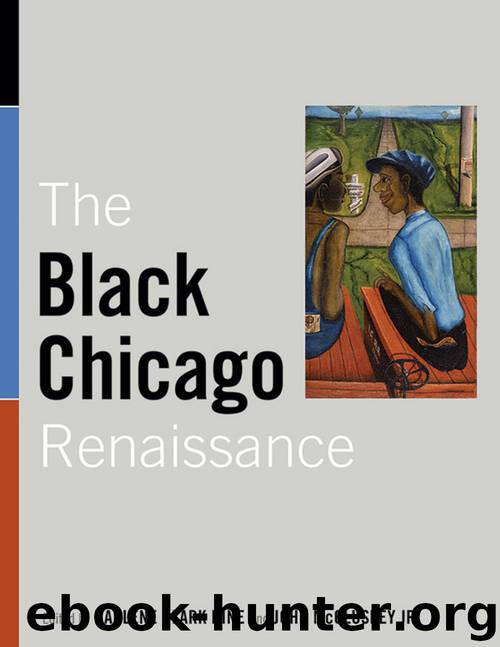The Black Chicago Renaissance by Darlene Clark Hine

Author:Darlene Clark Hine
Language: eng
Format: epub
Publisher: University of Illinois Press
Published: 2012-08-27T16:00:00+00:00
One aspect of any renaissance is experimentation against a background of tradition.
—CHINWEIZU, Africa and the Rest of Us
Either it [Negro writing] crept in through the kitchen in the form of jokes; or it was the fruit of the foul soil which was the result of a liaison between inferiority-complexed Negro “geniuses” and burnt-out white Bohemians with money.
—RICHARD WRIGHT, “Blueprint for Negro Writing”
Chapter 6
Richard Wright and the Season of Manifestoes
JOHN McCLUSKEY JR.
Richard Wright’s ten years in Chicago (1927–37), before the publication of Native Son and the completion of his full autobiography, American Hunger, were years of dazzling challenges and growth. He found work in the post office after a bout of gorging; he joined the Federal Writers’ Project and shrank smartly and swiftly from the open blade of a confused actor. He started composing blues and haiku poetry. He befriended eminent sociologists at the University of Chicago. He joined the John Reed Club, later the Communist Party, and helped launch the South Side Writers’ Group. He crafted his first short stories. These experiences culminated in the development of his novels, Native Son and Lawd Today, as well as the story collection Uncle Tom’s Children. The lessons from these encounters resonate also through his nonfiction, such as 12 Million Black Voices and early essays. This essay explores the early journalistic writings, primarily through the Daily Worker, and the culmination of the diverse Chicago influences to his 1937 manifesto, “Blueprint for Negro Writing.” The essay will also place Wright’s essay into an ever-widening circle of contemporaneous black diaspora manifestos struggling with issues of color, caste, and nationalism.
Often, the lead article or essay in an early, if not the first, issue of a small journal, the manifestoes were typically direct assaults on preceding traditions. The earlier traditions were the result of disruptions—colonialism in the cases of Caribbean and African nations—and literary expressions regarded as inauthentic. A new direction promised a bold return to a purer expression, a core from which new literary expressions reflect a more assertive group ethos. Such statements were often sweeping literary and cultural declarations of independence. They have served as urgent and crafted assertions of shifts in aesthetics and ethics. The new would be built upon a recovery and extension of the old. For some, it took the shape of experimentations against the traditional rhythms of music, as in the work of Nicolas Guillen utilizing the rhythms of the Cuban son or Sterling Brown’s use of classic blues. For others, it might have meant the locating within a folk tradition the heroic gestures and rhetoric of primary characters, as in the case of Jacque Roumain in Masters of the Dew. Further, it was a set of assertions of a nationalist spirit and an imagined past, as with the Negritude poets. In most statements, whether for ideological or strategic reasons, the call was to end provinciality and to align themselves with other writers/thinkers, regardless of color, who wished to join in common cause against the forces of injustice. Thus, the stance
Download
This site does not store any files on its server. We only index and link to content provided by other sites. Please contact the content providers to delete copyright contents if any and email us, we'll remove relevant links or contents immediately.
| Africa | Americas |
| Arctic & Antarctica | Asia |
| Australia & Oceania | Europe |
| Middle East | Russia |
| United States | World |
| Ancient Civilizations | Military |
| Historical Study & Educational Resources |
Underground: A Human History of the Worlds Beneath Our Feet by Will Hunt(11841)
Sapiens by Yuval Noah Harari(5125)
Navigation and Map Reading by K Andrew(4892)
The Sympathizer by Viet Thanh Nguyen(4096)
Barron's AP Biology by Goldberg M.S. Deborah T(3947)
5 Steps to a 5 AP U.S. History, 2010-2011 Edition (5 Steps to a 5 on the Advanced Placement Examinations Series) by Armstrong Stephen(3638)
Three Women by Lisa Taddeo(3281)
The Comedians: Drunks, Thieves, Scoundrels, and the History of American Comedy by Nesteroff Kliph(2994)
Water by Ian Miller(2957)
Drugs Unlimited by Mike Power(2486)
The House of Government by Slezkine Yuri(2105)
DarkMarket by Misha Glenny(2103)
A Short History of Drunkenness by Forsyth Mark(2069)
And the Band Played On by Randy Shilts(2017)
The Library Book by Susan Orlean(2004)
Revived (Cat Patrick) by Cat Patrick(1899)
The Woman Who Smashed Codes by Jason Fagone(1875)
The House of Rothschild: Money's Prophets, 1798-1848 by Niall Ferguson(1810)
Birth by Tina Cassidy(1804)
